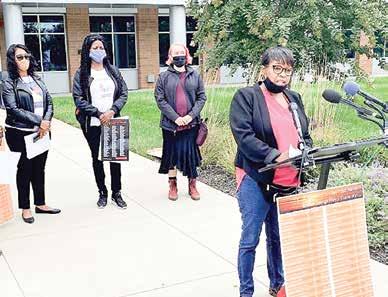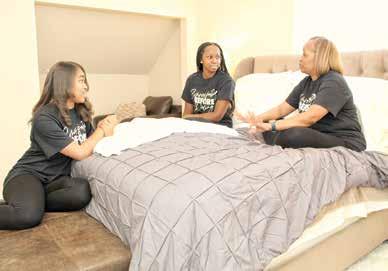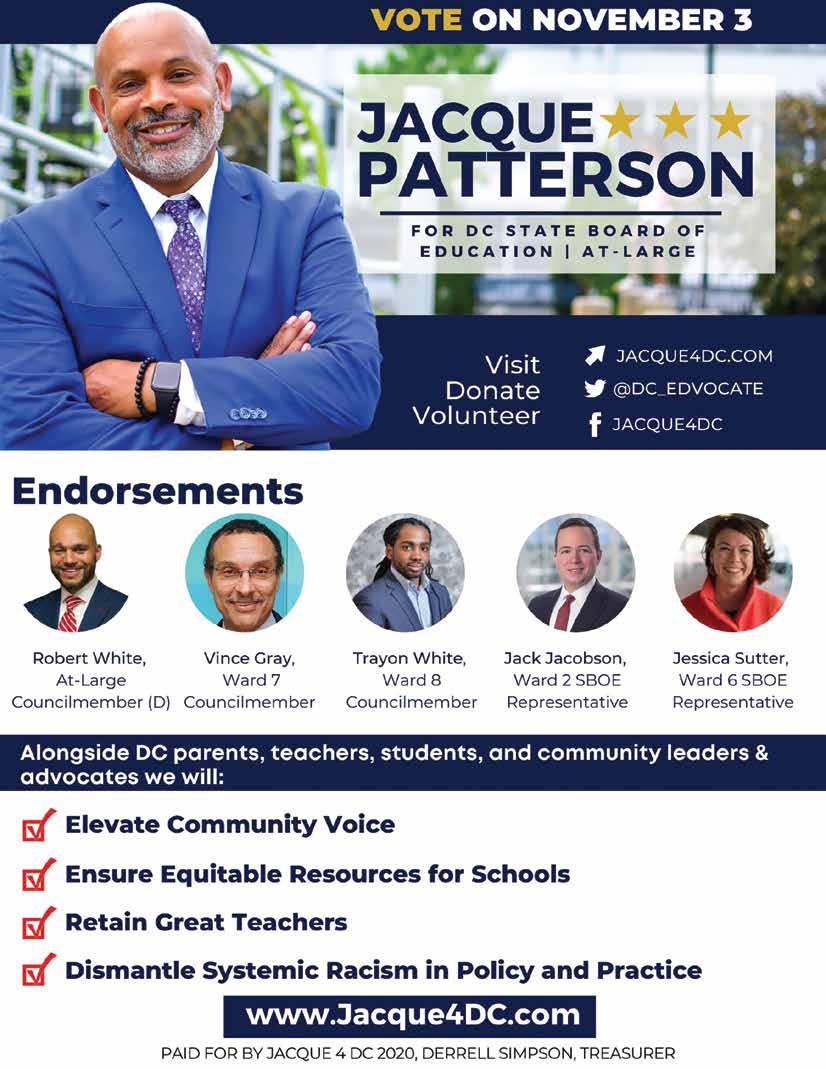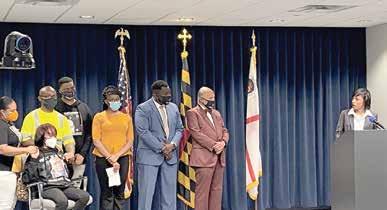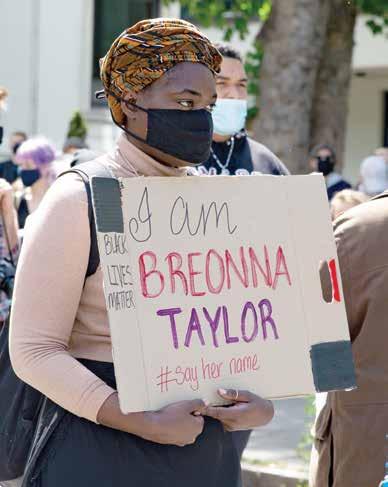
19 minute read
Lifestyle
Recent & Recommended Books for Election 2020
By Lee Ross WI Contributing Writer
Among the great advantages of American citizenship are the rights and responsibilities associated with voting. Many outside the U.S. look in envy at the power and inclusion afforded under democratically elected leaders. Still, with highly polarized elections, key issues important in the process of electing officials take a backseat to sensationalized news stories, candidate popularity, and rumors. The Washington Informer encourages every American to vote as a function of their civic duty, their birthright, and their national obligation. To do so, you must be as informed about the issues facing your community, your state, and the nation – as well as those candidates who believe they are the best options for leading the charge and managing your concerns.
The Ultimate Guide to the 2020 Election: 101 Nonpartisan Solutions to All the Issues that Matter
by Ryan Clancy and Margaret White With the 2020 US presidential election looming, the emerging contest doesn’t seem so much a battle of ideas as it does a war of two tribes bent on the other’s destruction. The Far Left and Far Right increasingly dominate and drive America’s political debate, leaving a majority of Americans feeling left out and left behind. The Ultimate Guide to the 2020 Election gives a voice to this majority and provides an unbiased education on the true nature of the problems America faces on several key issues, including: Health Care, Energy & Climate Change, Infrastructure, Big Tech & Privacy, The American Dream, Immigration, The National Debt, and Gun Safety. Ryan Clancy and Margaret White present ideas for rescuing American democracy itself.
Election Meltdown - Dirty Tricks, Distrust, and the Threat to American Democracy
by Richard L. Hasen As the 2020 presidential campaign begins to take shape, there is widespread distrust of the fairness and accuracy of American elections. In this timely and accessible book, Richard L. Hasen uses riveting stories illustrating four factors increasing the mistrust. Voter suppression has escalated as a Republican tool aimed to depress turnout of likely Democratic voters, fueling suspicion. Pockets of incompetence in election administration, often in large cities controlled by Democrats, have created an opening to claims of unfairness. Old-fashioned and new-fangled dirty tricks, including foreign and domestic misinformation campaigns via social media, threaten electoral integrity. Inflammatory rhetoric about “stolen” elections super charges distrust among hardcore partisans.
Home Rule or House Rule: Congress and the Erosion of Local Governance in the District of Columbia
by Michael K. Fauntroy Article I, Section 8, Clause 17 of the Constitution of the United States grants Congress complete authority over the seat of government, the District of Columbia. This clause creates an infirmity that renders the residents of the District without the same measure of democracy enjoyed by Americans in the states. Various remedies have been attempted, none of which put the residents of the District on par with their fellow Americans. This book presents a political analysis of the relationship between Congress and the local government of Washington, D.C. It examines the influence of suburban members of Congress on District affairs, the fiscal crisis of the 1980s and 1990s, governmental inefficiency, and the Control Board.
Democracy’s Capital: Black Political Power in Washington, D.C., 1960s–1970s
by Lauren Pearlman
From its 1790 founding until 1974, Washington, D.C.--capital of “the land of the free--lacked democratically elected city leadership. Fed up with governance dictated by white stakeholders, federal officials, and unelected representatives, local D.C. activists catalyzed a new phase of the fight for home rule. Amid the upheavals of the 1960s, they gave expression to the frustrations of black residents and wrestled for control of their city. Bringing together histories of the carceral and welfare states, as well as the civil rights and Black Power movements, Lauren Pearlman narrates this struggle for self-determination in the nation’s capital. She captures the transition from black protest to black political power under the Lyndon Johnson and Richard Nixon administrations and against the backdrop of local battles over the War on Poverty and the War on Crime. As Pearlman reveals, this conflict laid the foundation for the next fifty years of D.C. governance, connecting issues of civil rights, law and order, and urban renewal.
ES
Are You Registered to Vote?
Submitted by This past year the League DC League of Women Voters launched our People Powered Fair Maps Campaign (PPFM) in all
You may hear that question 50 states and the District of Cowhen you talk to a member of the lumbia. We think that maps that DC League of Women Voters. We determine the lines of Congressioask if you are registered to vote nal districts (and Ward districts in at your current address with your DC) should be drawn by indepencurrent name. We want to register dent, non-partisan commissions every eligible voter, including rewith transparency and fairness. turning citizens, incarcerated citiPartisan gerrymandering is not fair zens, native Washingtonians, new and is damaging to our democracy US citizens, including you! because it prevents fair representa
The US League is 100 years tion of everyone. We oppose all old this year and was established voter suppression and are working to help people become informed hard through legislation and lawcitizens. We envision a democsuits in many parts of the country racy where every person has the to stop such practices. The DC desire, the right, the knowledge, League of Women Voters is parand the confidence to participate. ticipating in PPFM by working to We work to secure equal rights get ON the map as a state. and equal opportunity for all. We The DC League is also 100 years also promote social and economic old this year! We called ourselves Nationwide candidate info justice and the health and safety the “voteless League of Women Polling place locations of all residents. As a non-partisan Voters” in 1921. We work to gain Online voter registration tool organization we want to make sure full rights for DC citizens and imID requirements that people know who is on the prove the living and working conballot so they can make educated ditions of our communities. Over choices when they vote. You can the years, we pushed for Child go to Vote411.org and put in your address to find out who is on your ballot and what they say for themselves. Labor Laws, opposed “clearing slums”, called for safe and sanitary public housing, and took on gun control. The DC League desegregated in 1944, declared “segregation is discrimination” in 1946, and elected our first African American president in 1963. For more history, see our Centennial Timeline at www.lwvdc.org. What does “full rights” mean? It means joining the rest of the United States by becoming a state, fully equal to the other 50 states. We would
The DC League is also 100 years old this year! We called ourselves the “voteless League of Women Voters” in 1921. We work to gain full rights for DC citizens and improve the living and working conditions of our communities. have 2 Senators like the other states, and representatives according to our population (right now we are entitled to one). It also means we would have full local control of our laws, our judicial system, our budget. It means that the President could not order in troops without our governor’s consent. The United States would still have a national capital in a smaller federal district. The dis

Absentee ballot info Ballot measure info Early voting options Election dates

trict would hold the Capitol building, the Supreme Court, the Mall, White House, monuments and congressional office building and Congress would have total control over it. Our neighborhoods—our fire stations, hospitals, schools, grocery stores, gas stations, restaurants, and homes where 705,000 of us live and work would all be in the new state.
This year has been historic for DC in our fight for Statehood. The Washington, DC (Douglass Commonwealth) Admission Act has passed the House for the first time ever. The bill is on the Senate floor for the first time ever. We need the Senate to pass the bill and the sitting president to sign it to become the 51st state just like all the other 37 states have entered the Union after the first 13— through a majority vote. If it does not pass this time, the bill will be reintroduced in the next Congress.
League members have traveled all over, visiting 30 states and Hong Kong. We know just how

little people living in the 50 states understand about how DC is governed and why we need to become a state. Congresswoman Eleanor Holmes Norton is a powerful voice for DC in the House, but she cannot vote on the House floor. And, without Senators, DC has no vote on Supreme Court judges, and can get shortchanged like we did on COVID-19 relief funding. When people hear that we have more people than 2 states, we pay taxes, serve in the military, hold regular jobs like they do, they support our drive for statehood. You can help by asking your friends and relatives who live in the 50 states to sign our petition supporting statehood at www.lwvdc.org. You can invite us to talk to your community group (on Zoom, for now) by writing to statehood@lwvdc.org. We invite you to join the League at www.lwvdc.org. We want to have all our DC communities represented on our member rolls. We welcome anyone over 16 years old. ES
Ready, Set, Vote! What You Need to Know to Vote Safely in the District of Columbia
The D.C. Board of Elections is mailing a ballot to each of the city’s more than 500,000 registered voters in early October and expanding in-person early voting to give voters more options.
• D.C. residents can use absentee ballots to safely vote from home. They can also avoid Election Day crowds by voting early and in person at 32 polling locations from Oct. 27 through Nov. 2. • Beginning in October, voters will be able to track the status of their mail-in ballots on the Board of Elections website. • The Board of Elections will use 95 of its usual 144 polling places on Election Day because smaller venues cannot accommodate social distancing.
How do I register to vote?
You can download a registration application from the Board of Elections website and email, mail or fax it back, or deliver it in person. If you can’t download the application, request one from the Board of Elections.
Applications submitted online or by mail must be received by Oct. 13. But you can also register in person as late as Election Day.
The D.C. Board of Elections is also mailing paperwork to registered voters to confirm their address and voter information. You need to return it only if you spot incorrect information or if you’d like your ballot sent to another address. If you return it, be sure to send the entire form to the Board of Elections.
How can I get an absentee ballot? Are there important deadlines?
All registered voters will be mailed a ballot and a postage-paid return envelope. You can also download an absentee ballot request form. Completed ballots must be postmarked by Election Day and must arrive no later than Nov. 13 — 10 days after Election Day.
How do I know my absentee ballot is secure?
Each voter’s ballot has a unique bar code. The D.C. Board of Elections has been using the process successfully for 20 years. Voters can drop off a completed mail ballot in ANY Ballot Drop Box at ANY time before 8 pm on Election Day, November 3, 2020. There will be at least five boxes in each Ward.
When is Election Day? When are polls open?
Election Day is Tuesday, Nov. 3. Polls are open from 7 a.m. to 8 p.m. There will be fewer polling places open because of the coronavirus, so voters may not be able to vote at their usual polling place. Check for the polling place closest to you at the Board of Elections website, under registration status.
Can I vote in person before Election Day?
D.C. will offer early voting at 32 polling locations beginning on Oct. 27 and running through Nov. 2, the day before Election Day. Polls will be open from 8:30 a.m. to 7 p.m. Check out the district’s early voting information portal to find the location of all early voting centers. You can cast your ballot at any of these locations.
There will be six Super Vote Centers throughout the city that can accommodate large numbers of voters, both during early voting and on Election Day. These include: • Capital One Arena in Ward 2 • Dock 5 @ Union Market in Ward 5 • Entertainment and Sports
Arena in Ward 8 • Omni Shoreham Hotel in
Ward 3 • Nationals Park in Ward 6 • University of the District of
Columbia in Ward 3.
What form of identification do I need to vote?
Registered voters do not need to show ID, unless you’re voting for the first time and registered online or by mail. Then you’ll need to show a valid government-issued photo ID, such as a driver’s license or U.S. passport, or a recent utility bill or bank statement. See the full list of acceptable IDs.
What is being done to make polling places safe from coronavirus?
Polling places will have hand sanitizer, masks, gloves, disinfectant and social-distancing markers.
Will be curbside voting be available for older adults or those with disabilities who vote in person?
Voters over the age of 65 and voters with a disability who choose to vote in person can take advantage of curbside voting at all polling locations
except for Super Vote Centers.
ES
District of Columbia
Your Vote. Your Voice. Our Fight.
As our nation battles a pandemic and economic downturn, the health and financial security of voters over 50 are on the line. That’s why AARP DC is fighting for your voice to be heard. AARP DC wants to make sure that you know all of your voting options and that all Americans—from working parents to family caregivers to seniors in nursing homes—can vote safely whether they choose to vote from home or in-person. For more information on how you can vote safely and make your voice heard, visit aarp.org/DCvotes
facebook.com/aarpdc | @AARPDC | aarp.org/DC
PAID FOR BY AARP
The Maryland State Board of Elections has taken a number of steps to ensure eligible Maryland voters can safely cast their general election ballots in the midst of the COVID-19 pandemic.
To reduce exposure to the novel coronavirus, Maryland voters are encouraged to vote by mail in the 2020 general election. Eligible voters across the state have been mailed applications for mail-in ballots along with postage-paid return envelopes to submit their applications. Voters’ requests for mail-in ballots must be received by October 20. Mail-in ballots will be sent to voters via first-class U.S. Mail beginning in late September and continuing through October.
In order to be counted, mail-in ballots must be postmarked no later than November 3 and the oath on the postage-paid return envelope that arrives with the ballot must be signed.
“Voting by mail is safe, easy and free,” said Maryland State Board of Elections Administrator Linda Lamone. “We encourage all eligible voters in the state to request their ballots early and cast their votes early.”
In addition to voting by mail, voters will have the option of submitting the mail-in ballots at ballot

drop boxes located throughout the state. Each Maryland jurisdiction will have at least two ballot drop box locations available to voters. The state’s most populous counties and the City of Baltimore will have additional ballot drop boxes to ac

2020 Presidential General Election
Tuesday, November 3, 2020 STAY SAFE. VOTE-BY-MAIL.
Step 1:
REQUEST A BALLOT - MUST BE RECEIVED BY OCTOBER 20
To vote-by-mail in the 2020 Presidential General Election you must request a ballot. Your ballot request must be received by October 20.
Step 2:
LOOK OUT FOR YOUR BALLOT
You can track your ballot application status online. Ballots will begin arriving in early October. Step 3:
COMPLETE YOUR BALLOT & SIGN THE ENVELOPE
Follow the instructions.
Step 4:
RETURN YOUR BALLOT BY NOVEMBER 3
Return your completed ballot to an official election drop
box by 8pm on November 3
or postmark by November 3.
ARE YOU REGISTERED? To be eligible to vote, you must register or update your voter registration information by Tuesday, October 13. or vote in-person
EARLY VOTING October 26–November 2
7am–8pm
ELECTION DAY November 3
7am–8pm
Learn more about registering, requesting a ballot, or in-person voting options at
ELECTIONS.MARYLAND.GOV/2020 commodate the greater number of eligible voters residing in those jurisdictions. Voters can submit their completed mail-in ballots at any drop box located in their jurisdiction of residence.
In all, 282 ballot drop boxes will be available at 281 locations around the state. Two ballot drop boxes will be available at Camden Yards in Baltimore. The complete list of ballot drop box locations is available at: https://elections. maryland.gov/elections/2020/ PG20_Drop%20Box%20Locations.xlsx
Just as with ballots submitted by mail, in order for ballots submitted at drop boxes to count they must be sealed in the return envelopes that accompany the ballots and the voter oath on the envelope must be signed. Ballot drop boxes will begin opening around the state roughly 30 days prior to Election Day, November 3. Once open, the ballot drop boxes will remain open until 8 p.m. on Election Day.
Voters may also drop their completed, signed and sealed ballots at local election board offices. Due to the COVID-19 pandemic, office hours may be adjusted. Voters should call their local board of elections to confirm office hours and locations.
In-person voting will be available during eight days of early voting – from Monday, October 26 to Monday, November 2 – and on Election Day, November 3. To make in-person voting safe, voters must remain six feet apart and wear a mask. To maintain proper distancing, the number of voters permitted inside a voting center at one time may be limited, which could result in lines and wait times.
Early voting centers and Election Day vote centers will be open from 7 a.m. to 8 p.m. Eligible voters may cast their ballots at any authorized voting location within their jurisdiction of residence.
A complete list of early voting locations can be found here: https://elections.maryland. gov/elections/2020/2020%20 Early%20Voting%20Centers.pdf
A complete list of Election Day vote centers can be found here: https://elections.maryland.gov/ elections/2020/PG20_List%20 of%20Election%20Day%20 Vote%20Centers.xlsx
“This public health crisis has resulted in a number of changes to the way Marylanders will cast their ballots this fall, but we are confident every eligible voter will have the opportunity to safely exercise their right to vote,” said Lamone. “Our message to all Marylanders is don’t wait – don’t wait to apply for your mail-in ballot and don’t wait to cast your vote.”
ES

Jacque Patterson: The Parent Choice for State Board of Education At-Large
When I first moved to Washington, DC, 25 years ago, I was a single father with a little girl. At the time, Ward 8 didn’t have any grocery stores, a single sit-down restaurant or any place for my daughter to play. While the rest of the city enjoyed the very things that make a community strong, Ward 8 went without. So, I rolled up my sleeves and went to work. I was elected to serve as the advisory neighborhood commissioner in my neighborhood and I begam working with residents and other community leaders to assist in building the Town Hall Education Arts & Recreation Center (THEARC). We worked with Mayor Anthony Williams to get the Giant grocery store built, replace the check cashing place with Andrews Federal Credit Union, and rebuild the Douglass Stanton Dwelling into a mixed-use affordable housing community. It didn’t matter that my first elected office was an unpaid “advisory” position, it was about organizing a community around the common good. I’ve always believed that it’s not the power of the position you hold, but about empowering the people you lead. For the past 10 years, I have been working as a lead
5 It’s important that we elevate the parents’ voice in public education because they are an instrumental part of a student’s academic success, as we’re finding out even more during this pandemic and distance learning.

er in public education at Rocketship and KIPP DC to ensure students and parents have quality education options in their community as well as amplifying community and parent voices in our schools.
The role of a State Board of Education representative is to provide educational policy leadership and advocate for needed change to ensure that every student is valued and learn the skills and knowledge necessary to become an informed, competent and contributing global citizen. Currently, I am the only candidate who has relationships with current members on the SBOE; Ward 6 representative, Jessica Sutter, and Ward 2 representative Jack Jacobson as well as members of the DC council; Robert White, Jr., Vince Gray and Trayon White. These relationships are pivotal to getting policy implemented for students, teachers and parents and as the AtLarge representative, I will leverage these relationships to ensure that our school are equitably resourced, retain the best teacher talent and are more anti-racist in policy and practice.
I’m running for the State Board of Education, At-Large seat because public education needs that same kind of community support to make it more equitable for every student, regardless of their zip code. The lessons I have learned in helping to revitalize my community and build relationships across the District, I’ll bring to the State Board of Education; starting with our parents. If elected to the State Board of Education, I’ll be the only father with school age children enrolled in DC Public Schools. It’s important that we elevate the parents’ voice in public education because they are an instrumental part of a student’s academic success, as we’re finding out even more during this pandemic and distance learning. I believe that we must organize and elevate the community’s voice around the issues that impact marginalized neighborhoods where educational inequities have become status quo. The quality of a neighborhood starts with the quality of education it provides its residents, regardless of their zip code. It’s time that we elected parent leaders to the SBOE.
More than ever, we need proven leadership to truly close the equity and opportunity gap in communities across DC. I’m looking forward to representing every student, teacher, family and community as the at-large representative on the DC State Board of Education. I’m the only candidate running that has 20 plus years of experience in community advocacy and educational leadership. That’s why I’m asking you to join our campaign for a more equitable DC education system and vote for Jacque Patterson on November 3rd. ES

PAID FOR BY JACQUE 4 DC 2020

